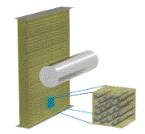Mechanical and Materials Engineering, Department of

Department of Engineering Mechanics: Dissertations, Theses, and Student Research
Date of this Version
12-2010
Document Type
Thesis
Abstract
The prevalence of traumatic brain injury (TBI) in American soldiers exposed to a blast wave has created an urgent need to better understand the effects of blast wave insult to the head. Developing techniques that can experimentally simulate well controlled blast waves in a laboratory environment is a critical component of the research efforts towards this goal. For this work, a 4-in. cylindrical uniform shock tube and a nonuniform shock tube combining a 4-in. cylindrical gas driver with a 9-in. square driven section have been developed. The hosting laboratory, gas handling system, multichannel data acquisition systems, and the related network and software for computerized remote operation were also developed. These shock tubes were designed for generating shock waves with the overpressure and underpressure profiles mimicking those of the Friedlander wave. This wave form is a commonly used representation of the typical blast wave-form in an open-field. Tests have been performed to validate the designs and to characterize the shock waves generated by the two devices.
The results of experiments with the 4-in. shock tube show that shock waves with sub-microsecond rise times can be reliably generated with the membrane burst mechanism used. Various thicknesses of Dura-Lar® (biaxially oriented polyethylene terephthalate) were examined as a membrane material, the burst pressure was found to depend linearly on the number of sheets used. It was also found that the shock front propagation speed and amplitude agree with the one-dimensional shock wave theory for ideal gas even at the tube wall indicating a planar wave front in the shock tube. Hence, the device can be used to accurately calibrate pressure sensors mounted through the wall.
The 9-in. square shock tube is a novel set-up. It enables the use of flat windows, which are necessary for digital imaging, optical measurements and provides sufficient space and versatile sample mounting for in-tube blast testing not feasible with the cylindrical design. It also employs a unique adjustable reflector near the tube exit to achieve underpressure profile control, which is critical for blast testing of animal models. Systematic testing has been performed for this device. Although the transitional flow between the driver and the driven section is multi-dimensional, the test results show that an essentially planar shock wave is formed before entering the test section. The peak overpressure and wave profile were found to vary with location. The correlation between the membrane burst pressure and the peak overpressure in the test section was determined experimentally. These experiments have demonstrated for the first time that the Friedlander type of blast wave can be generated in such a shock tube with a right combination of driver gas, driver length, burst pressure, and reflector position. The setup can thus be a powerful tool for TBI-related studies.


Comments
A thesis Presented to the Faculty of The Graduate College at the University of Nebraska In Partial Fulfillment of Requirements For the Degree of Master of Science, Major: Engineering Mechanics, Under the Supervision of Professors Ruqiang Feng and Professor David H. Allen. Lincoln, Nebraska: December, 2010
Copyright (c) 2010 Aaron Douglas Holmberg